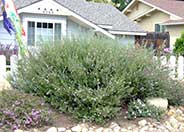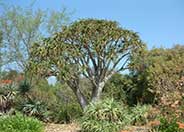
Common name:Fox Tail Agave, Velvet Agave
Botanical name:Agave attenuata
This Agave has a dramatic tropical form. Even light frost can damage its succulent leaves. It is great for containers. In the low desert, partial sun will be best. If it becomes top heavy, simply cut and stick in the ground to root. It is not a fast grower and has light green foliage. It will also die after flowering but pups around the mother will survive. Distinctive with its large rosette of leaves perched on a long curving trunk, it is a native from Mexico.

Common name:Aeonium cultivars
Botanical name:Aeonium cultivars
These plants are one of the most useful succulents, due to their decorative effects and sculpturesque quality. The branched stems hold a wide rosetta of either light green or purple leaves. The flowers appear in long, clustered form. They need some shade in hotter areas. Prostrate forms are low-growing, and spreading.

Common name:Orange Sedum
Botanical name:Sedum nussbaumeranian
This succulent perennial will grow best in a wall pot or hanging basket due to its long stems. It has light, gray green leaves that grow over one another to give off a "braided" look. The flowers are pink to deep red and bloom in spring and summer.

Common name:Australian Rosemary
Botanical name:Westringia fruticosa
The Australian Rosemary is an evergreen shrub that grows 3'-6' tall. It has soft, gray green leaves and white flowers throughout the year and prefers sun and little to average amounts of water. This shrub is also drought tolerant.

Common name:Bougainvillea selections
Botanical name:Bougainvillea cultivars
This species is hardy and vigorous, with a showy, ornamental display of purple color. It blooms well in areas with cool summers.
It is senstive to frost and will die back hard but comes back in a number of weeks. Be carefeul of this in the Santa Ynez Valley.

Common name:Paperbark Tree, Cajeput Tree
Botanical name:Melaleuca quinquenervia
Paperbark or Cajeput (Melaleuca quinquenervia) is an Australian native that is known for its beautiful, papery bark that unravels in sheets on the trunk. The tree can reach 40’ tall and 15’-25’ wide. It is often grown as a multi-trunk tree, and it makes a beautiful specimen tree in a wide range of garden styles. It is unparticular about its soil, and it can thrive in a wide range of moisture conditions. If this tree is selected for a small- to medium-sized garden, measures must be taken to keep topical roots from forming. Drip irrigation or deep, infrequent watering is best. If this tree is planted near an area with overhead sprinklers, root barriers may be necessary to keep roots away from the wetter parts of the garden. Once the tree reaches a size where it could benefit from some shaping, it is best to have a licensed arborist perform the work. This tree should be planted at least eight feet away from any hardscape areas, 15 feet from structures such as houses and buildings, and not near any powerlines. Shrubs and perennials should be planted about five feet away from this tree. It should be irrigated for about 45 minutes once a week when using most in-line drip irrigation systems.

Common name:Tree Aloe
Botanical name:Aloe barberae
A succulent with upright thick mottled gray stems. The terminal branches hold rosettes of recurved, dark green leaves. In late winter, the rose-pink flowers in a tight inflorescence rise above the foliage.
Designer: N/A
Photographer: GardenSoft
Maintain a two to four inch layer of mulch on the soil surface to reduce weeds, infiltrate rain water, and reduce compaction.
Drip and other smart irrigation delivers water directly to roots, allowing no excess water for weeds.